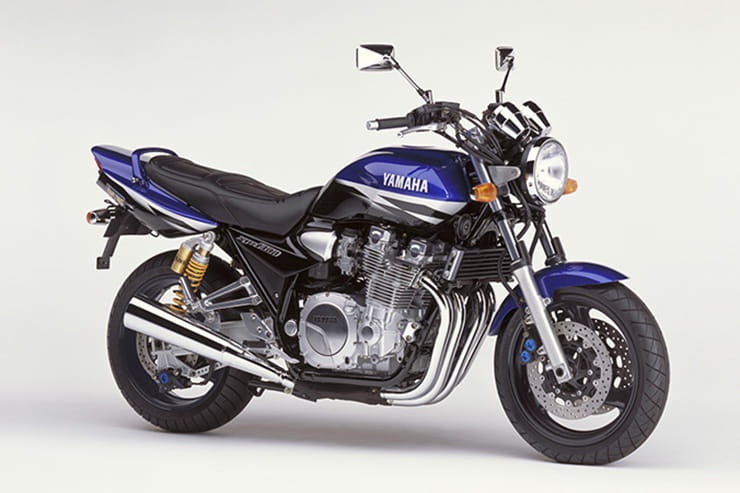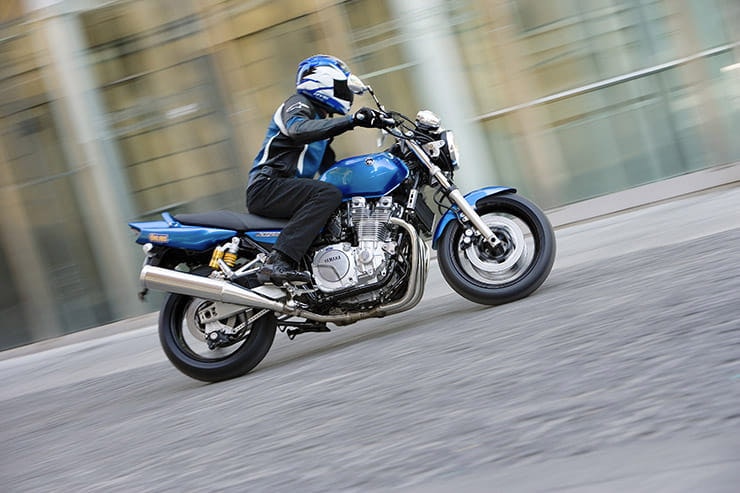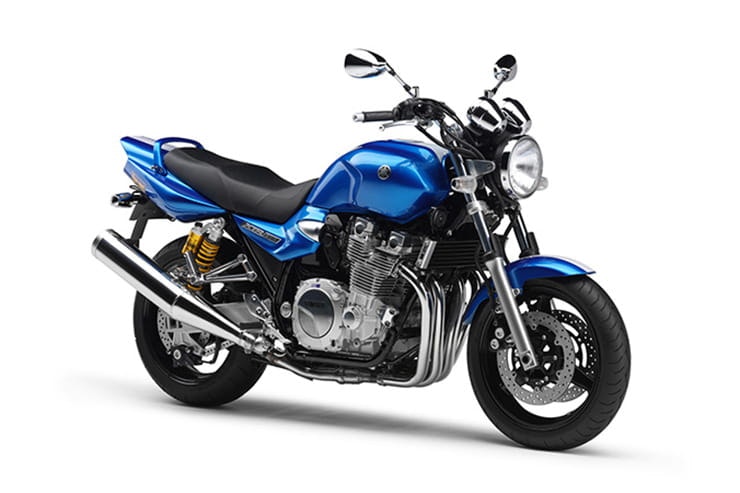Yamaha XJR1300 (1999-2014): Review & Buying Guide
By Jon Urry
Massively experienced road tester
14.03.2023
Price: £3000-£6000 | Power: 98bhp | Weight: 245kg | Overall BikeSocial Rating: 4/5
The Yamaha XJR1300 was a mainstay in the firm’s model range and aside from a very few slight updates, basically stayed the same for nearly 15 years. And even when it was ‘redesigned’ in 2015, the bare bones of the bike were pretty much identical! A superb machine for cruising around on that is powered by a proper old-school big-capacity air-cooled motor, the XJR has a huge fanbase thanks to its cool looks, fun nature and practicality. If you want a retro that your pillion will actually want to hop on and join you for a ride come a sunny Sunday, the XJR is the one for you. And if you fancy getting the spanners out and giving it a few modern updates, well, that’s certainly an open door...
Yamaha XJR1300 (1999-2014) Price
The XJR1300 has been around since 1999 (or 1995 if you include the XJR1200) and as such there are loads of used examples out there that cover a wide range of prices. If you want a bargain, you can pick an early model up for as little as £2500 in a private sale but as the XJR is as much about looks as it is the ride quality, you are better off spending a bit more and getting a good one. Set your starting figure at £3000-£3500 and you can get a nice example of an early carbed model with the best option the post-2002 models as they come with Öhlins shocks as standard or an earlier SP which also has them. If you want fuel injection (2007-onwards) then you need to pay about £4000 as a minimum, which isn’t bad value. A dealer will ask for just under £6000 for a late ‘old-style’ XJR1300. There are few bargains as such to be had due to the XJR’s popularity but if you take your time, buying a good quality bike in a private sale is the best option as reliability is excellent on the XJR and you should save about £500-£800 over a dealer’s asking price.
Ultra-smooth inline four with bags of character
Easy to work on if required
Great two-up cruiser
The handling needs firming up
There are a few dogs out there, so care needs to be taken when buying
Compared to other big-capacity rivals, the XJR could do with more grunt
Engine and Performance
The XJR is proper old-school in its performance and the 1251cc inline four is a real reminder about what made the Japanese factories so successful in the 1970s and 1980s. Air-cooled, the XJR’s double overhead cam motor has four valves per cylinder and a lovely long stroke, meaning it delivers lots of mid-range drive. A beautifully relaxing and smooth engine to use, it may only have five gears but that’s not a massive hardship as you generally just stick it in top and keep the speeds to below 70mph anyway. The air-cooled motor is at its happiest below 7000rpm, so don’t try revving it hard and instead just sit back and relax. It really is a beautiful motor that while not the fastest, has bags of soul.
When buying used there is quite a debate about which generation of XJR to go for as they all have their own individual quirks and things to look out for. Starting with the similarities, the five-speed gearbox is generally very sound but by now the motor’s electrical components such the generator and/or reg/rec could be on the way out so check all seems well. The valve-clearances should be inspected every 12,000 miles (half what Yamaha state on water-cooled models) so have a good look at the service history to see when it was last done. As the engine is very easy to access it costs about £300-£400 to get done alongside a service but that’s still a chunk of cash you will need to spend to be safe. Owners report the paint flakes off the engine quite badly if the bike is exposed to salt or just not cared for very well, so use this as a gauge to the previous owner’s care and attention, and check the oil level. As the bike will be quite old, always feel for a juddering from the clutch that hints it may be in need of some new plates and also inspect the chain and sprockets as well as the exhaust, which can rot. Now onto the individual quirks...
The first generation of XJR models, which ran from 1999-2006, had carbs with early modes running two exhaust end cans and later ones a single can. Carbed bikes suffer from modern fuel basically turning to jelly within them if left standing, which blocks up jets. If the bike starts merrily without any choke from cold, there is a fair chance it is running rich and therefore might need a carb rebuild. A rebuild kit costs roughly £20 a carb (there are four remember...) and is pretty easy to do yourself – however properly cleaning the carb itself can be a bit tricky. A lot of firms offer an ultrasonic carb cleaning service, which is great but if not done by a professional can strip the protective finish off the carbs so be careful who you choose and look at their online reviews. If the carbs are good but the bike doesn’t tickover nice and smoothly, assume a carb-balance is required, which again is an easy DIY job (a carb balancer vacuum gauge is less than £100) and makes a big difference to a bike’s performance and feeling on the throttle. Ok, onto fuel injection...
Fuel injection is generally more reliable than carbs and doesn’t require as much setting up but alongside fuel injection arrived an even bigger catalytic converter (there was one on the last carbed bike), which does sap a bit of performance. If you want it restored, de-cat link pipes are easy to locate and less than £100 to buy. And then there is the EXUP valve, which also arrived in 2007. As with all EXUP valves, check it is opening and closing freely and look for any warning codes on the dash when out on a test ride. Generally speaking, injected bikes are a better buy than carbed ones – but this is a hotly contested topic and fans of carbs insist they make the bike more economical and give it a smoother throttle response...
A large number of XJR owners tend to do simple DIY jobs themselves such as oil and filter changes. If there is a gap in the service history, this hints at a DIY fan which means you need to treat it to a very careful inspection as DIYers often skip things such as regular brake fluid changes and greasing bearings that a workshop will do as part of the bike’s set service schedule. If in doubt, download a service schedule from the internet and armed with a Haynes manual, give it a go yourself!
Yamaha XJR1300 (1999-2014) Handling & Suspension
The XJR is no lightweight and at 245kg wet is a lot of metal to control when you up the pace – which is one of the bike’s slight limitations. On standard suspension the XJR can wallow and weave a bit in bends, which is disappointing but not that hard to cure. Although the forks only have preload adjustment, getting them rebuilt is very easy and alongside a bit of tweaking of the Öhlins shocks’ settings will vastly improve the ride quality. Speaking of Öhlins shocks, only the SP model featured these until 2002 so ideally, buy a bike with them on as they are fully rebuildable where the basic OE shocks aren’t. When buying a used XJR, suspension is the major area that is likely to require money being spent on it so check it well and also see how the head bearings feel as may well need replacing by now. A few owners go the full hog and swap the telescopic forks for inverted items but these project bikes are best avoided, standard is always the better option to buy.
The brakes on the XJR are R1 hand-me-downs and as such can certainly deliver when it comes to stopping power. A set of braided lines and new pads should be all that is required if they are a bit underperforming but always check the state of the rear caliper as its under-slung positioning makes it very vulnerable to corrosion.
Comfort & Economy
The XJR is an extremely comfortable bike to ride with a huge and sumptuously padded seat, which makes it brilliant for two-up day trips (the pillion grab rail is massive) out and about. You can take one touring but a lack of wind protection does limit the mileage a bit. Speaking of mileage, a vast 21 litre tank and economy figures of over 50mpg mean the XJR can do over 250 miles on a tank, which is absolutely brilliant news. If you really do want to cover more miles, there are plenty of screen options and lots of owners fit heated grips and top boxes. Not only that, Yamaha even thoughtfully included neat bungee hook points as standard, making attaching throw-over luggage or cargo nets easy.
Yamaha XJR1300 (1999-2014) Equipment
You can’t expect a retro to come with much in the way of equipment and the XJR lacks even ABS. Does this matter? Not really. A few owners grumble that the clocks have a habit of packing up and the 2004-onwards bikes come with an immobiliser (ensure the red master key is included in the sale) but its lack of gizmos only makes the XJR even more reliable.
When it comes to accessories, exhaust end cans are common as are screens, heated grips and top boxes. You can buy belly pans to help keep the engine a bit cleaner and an oil cooler cover is worth investing in to protect it. Some owners swap the slightly weedy original bars for more chunky Renthal items, which is a cool addition, but just check the brake lines and throttle cables aren’t compromised when the forks are fully-extended!
Yamaha XJR1300 (1999-2014) Rivals
The XJR is generally bought by owners in the 40-60 years old bracket who are drawn to it by its old-school charm and excellent pillion ability – not to mention the cool speed block paint schemes! A few younger riders buy them for customisation but that’s not a big market and by now the hipster fashion is starting to tail off, so these owners are getting fewer and fewer.
Suzuki GSX1400 (2001-2006) | Approx Price: £4000-£7500
Power/Torque: 105bhp/93lb-ft | Weight: 229kg
Kawasaki ZXR1200 (2001-2007) | Approx Price: £4500-£8500
Power/Torque: 123bhp/81lb-ft | Weight: 223kg
Honda CB1100RS (2017-2021) | Approx Price: £7000-£9500
Power/Torque: 88bhp/67lb-ft | Weight: 252kg
Yamaha XJR1300 (1999-2014) Verdict
The XJR1300 is a great option for anyone looking for an occasional use bike that can be enjoyed either solo or with a pillion. A few small tweaks (mainly to its suspension) is all that is really required to make it absolutely ideal for this role in life.
Yamaha XJR1300 (1999-2014) – Technical Specification
Looking for motorcycle insurance? Get a quote for this motorbike with Bennetts bike insurance


